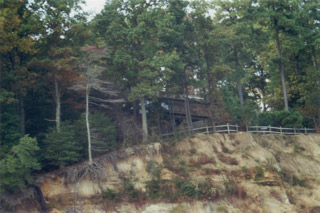Not really “River City,” but we did find trouble before we moved to our Chesapeake Dream. We learned there was erosion along the shoreline on the Chesapeake Bay before we brought our retirement house. We thought we had done our due diligence when we contacted the county’s environmental specialist to discuss the problem.
We were told the Bay’s shoreline erodes an average of 12-18 inches annually. That was a relief as our property had nearly 60 feet on the bay side. We figured we had at least 20 years before real problems occurred.

The Chesapeake Dream in December 2000
We planned to put in some form of shoreline erosion control when we moved. We were not told an endangered species, the Puritan tiger beetle, lived on the cliff and nothing could be done on the cliffs that would harm beetle habitat.
As mentioned in previous blogs, our house was used as a vacation rental for four years before we moved to Southern Maryland. We bought gently used furniture and new bedding for the three bedrooms and a sofa bed for the family room. The rentals paid the mortgage and for improvements. We felt good about our decision to buy before retiring. When the house was not rented, we enjoyed it with family and friends.
The year before we moved, in September 2003, Hurricane Isabel hit Maryland especially hard as it came up the Bay. It caused serious flooding in Baltimore, Annapolis and throughout the Bay’s coastal areas. Damage ran into millions of dollars. It taught us a hard lesson about shoreline erosion. While the average loss is 12-18 inches annually, when erosion occurs, it takes feet not inches. Trees have big roots and big trees have even bigger roots. When they go down it causes serious damage.

Chesapeake Bay shoreline after Hurricane Isabel hit in Sept. 2004
Our house was built in 1995 on a 70-feet cliff. Marvelous for viewing the Bay. Not so good when shore erosion occurs. Hurricane Isabel’s storm surge was eight feet high. That meant water rose eight feet above mean high water and flooded as it moved inland. After a hurricane or a superstorm, it’s the storm surge that usually causes the most damage. We were reminded of the high tides this past January with superstorm Jonas. We kept reminding ourselves we would have had to evacuate if were still at the Chesapeake.
Since we were not living at the Chesapeake, we drove down to our house the day after Hurricane Isabel to check on the house. We were relieved to find the house intact, but we found the shoreline looking very different. The beach was washed clean of previous slides and the many trees that had fallen over the years. The cliff’s base was solid dark clay for twenty to thirty feet up rather than huge mounds of sand that had been sliding down the cliff’s face over many years.
The cliff in front of our house did not show immediate evidence of weakness. Problems arose from loss of “buffer” slides at the cliff’s base. They had built up for so long they looked like a permanent part of the cliff. As high tides hit the cliff’s base, they undercut the exposed clay level and large chunks of clay began to break off. This process weakened the cliff all the way up to the top. Some months later, trees on the cliff’s side and at the top began to lean and slowly tilt downward.*
For the first two years after I retired and moved to the Chesapeake, I had a new job. It was a personal assignment. My job was to try and save our home. We waged a major public relations campaign with the help of fellow cliff homeowners. Our task was to get a permit to build revetment along our shoreline for erosion control.
The Takeaway: Have you had unexpected issues arise when you retired? Share them with this blog and let’s start a conversation. We can learn from each other and your input will help all of us as we face unexpected adversity. Please include your name and email or phone number so I may contact you if there are questions. I will not publish your name. Contact me at [email protected]
*A short geological discussion may provide a better understanding of issues with the Bay’s shoreline erosion. Maryland’s Calvert Cliffs are composed of sand and clay without hard surface like rock with their origin from the Miocene Age — about 12 million years ago.
The Chesapeake Bay was formed as a result of the last Ice Age — about 18,000 years ago. When mile-thick glaciers began melting they carved rivers and streams that flowed toward the Atlantic Ocean forming the Susquehanna River Valley. As water flowed southward, more land was submerged and eventually became the Chesapeake Bay.
Another event contributing to the Bay’s formation was an asteroid that hit Earth about 35 million years ago. About eight miles in diameter, the asteroid hit in the area now Virginia’s eastern edge. Its impact helped form the Bay’s mouth where it meets the Atlantic Ocean.
Many years ago the Bay had a much higher saline content and its aquatic life included scallops, sharks and whales. Now when chunks of clay slough off the cliff’s clay level, scallop shells, shark’s teeth and occasionally whale bones are prized finds by visitors and scientists alike.
